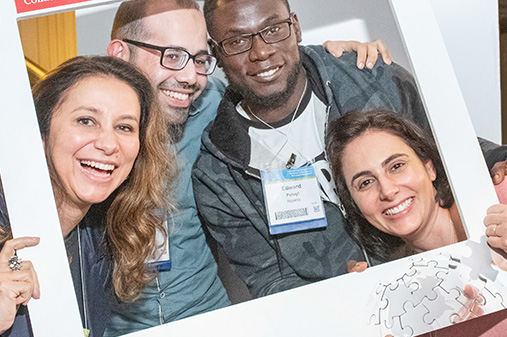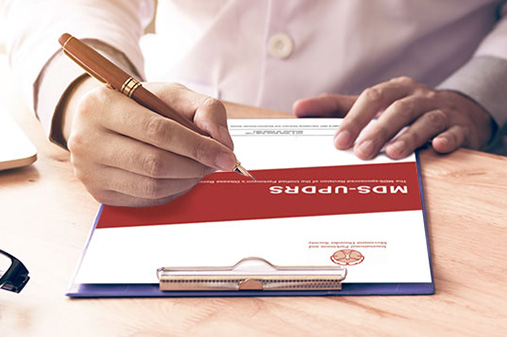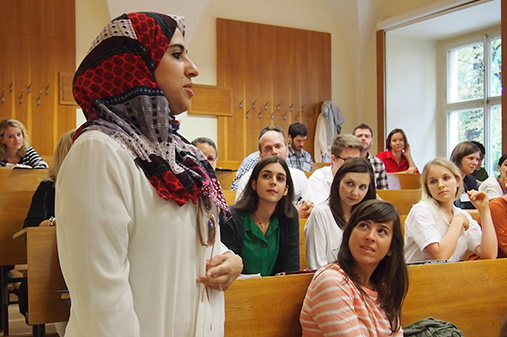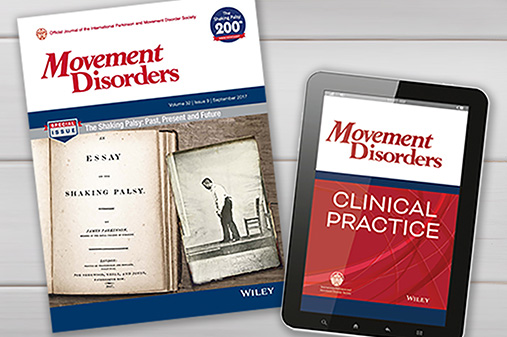Vibrotactile foot stimulation for freezing of gait
[00:00:00] Dr. Eduardo De Pablo Fernandez: Hello everybody and welcome to a new episode of the MDS Podcast, the official podcast for the International Parkinson and Movement Disorder Society. My name is Eduardo de Pablo Fernandez from the Center for Preventive Neurology at Queen Mary University of London. We are discussing today how vibrotactile stimulation can help the management of symptoms of freezing in Parkinson's disease.
I have with me Dr. Piu Chan from the Department of Neurology in Shanwu Hospital of Capital Medical University in Beijing, China. He is one of the senior authors of the article titled Vibrotactile Foot Device for Freezing of Gait in Parkinson's Disease, a pilot study recently published in the Movement Disorder Clinical Practice.
View complete transcript
Dr. Chan, thank you for joining us [00:01:00] today.
[00:01:00] Dr. Piu Chan: Thank you for the invitation, and it's a good honor to join your podcast for the Movement Disorder Clinical Practice Journal.
[00:01:10] Dr. Eduardo De Pablo Fernandez: So we're going to talk about your study on freezing of gait, but before we dive into your article freezing of gait is one of the most disabling symptoms in people with Parkinson's disease, and part of that is because the lack of response to dopaminergic therapies. But I find fascinating in some cases how much they can respond to external cues.
Can you tell us about different external cues and the pathophysiology behind this and how you can use this for therapeutic purposes.
[00:01:39] Dr. Piu Chan: Sure, I think first, freezing of gait or FOG is as you said, is a very common phenomenon which may occur in more than 50 percent of Parkinson's patients during the disease life course. So really it's a major problem, can increase the mobility and the mortality mainly [00:02:00] because of fall and the fracture.
So that's really a major issue or dysfunction leading to a worse quality of daily life. . Even though the routine drug treatment may, in some way, to relieve the symptom but it's not really curing and also we know that the drug is fluctuating, has a fluctuation on off.
So that really gives a lot of trouble to patients during their day, daily life. So traditionally there is a discovery from the so called external cueing that may help people or Parkinson's patients to relieve the freezing of gait I think that there are many types of this kind of cueing include visual like you use a laser light, and so the patient can follow the laser light and then initiate their steps or that can [00:03:00] help them relieve the freezing, or the second one will be a auditory kind of stimuli rhythm, music. And so the patients can follow listening the rhythmic music, and then they can move their legs.
So that can relieve their frozen of gait FOG. And the third type is mainly what we call here is the vibrotactic stimulation. Normally people use stimuli put in the body. Or part of the limb with the stimuli turned on the patients may help to initiate their steps.
But all of those in some way still has some kind of limitation. Because the therapeutic effect or the help may not constant and they need their attention. So far we don't really know the mechanism, how, this external curing can help people relieving their [00:04:00] freezing of gait. One of the theories because most people develop FOG is because they cannot control or basically there's a shift from the habitual motor control. Like we get used to walking certain ways or playing certain boards like golf. We get used to it. And when we're doing it, we're just doing it. We never think about it. So that kind of function is lost in Parkinson's patients. And so if we want to initiate movement. We have to tell the patients have to say, I want to walk, or I want to lift my leg, and then that will initiate the stepping functions, or the action.
Or you have to say, I'm stepping on the ground so I can make a turn. So those kind of phenomena exist in the daily life, so patients may use it to help them. We don't know why is that. I think I used to tell my patients in [00:05:00] a simple ways like because you lost your balance, so you while you're walking you may fall, so your brain will tell you don't walk.
It's your brain will automatically place a brake. And then so you use those external cueing to relieve the brake. And then you're starting walking. So I think this is what we know why those external cueing may help FOG patients.
[00:05:29] Dr. Eduardo De Pablo Fernandez: We are trying to switch from a semi automatic pattern to a more active motor activity that requires different pathways in the brain. That's very interesting. And you said that you are using this vibrotactile stimulation, using a specific device in the foot and insole in the foot.
As you said, there has been previous studies using different cues and using also vibrotactile stimulation in different parts of the body. But what's different about your device and can you tell us a bit more about the [00:06:00] advantages of this method?
[00:06:01] Dr. Piu Chan: So when we designed this device, one of the key point is that we're trying to see, can we initiate this vibrotile stimuli? Patients don't need to think about, oh, I have to walk, I'm going to walk, oh, I'm going to do something. That's really the fundamental goal that driven our design of this device.
So we thought, how about once the patient stand up, so there will be pressure on the food on the ground, and could that be used to trigger the vibration or how about if we have an algorithmhm. that can identify there is a FOG coming, or freezing coming. Could that be used to trigger the vibration?
So I think that's really the major differences from our device than other means that being used to help patients. So in our shoes one patient starting [00:07:00] stand up and, press the pressure on the ground and then the shoe, the vibration will be turned on basically.
[00:07:06] Dr. Eduardo De Pablo Fernandez: So it's basically a more on demand stimulation rather than like a constant, which as you discuss in the paper, that can lead also to problems with reliance on external cues and sorts of a tolerance to the stimulation.
[00:07:19] Dr. Piu Chan: Correct.
[00:07:20] Dr. Eduardo De Pablo Fernandez: Okay, so you evaluated this device in 33 people with Parkinson's disease and freezing of gait. And you video recorded and evaluated gait parameters and also freezing of gait. Can you tell us a bit more about these assessments and what results did you find in your study?
[00:07:36] Dr. Piu Chan: Okay. So basically we set up a scenario where patients have to walk a distance like 10 meters and then during that walking we will design some actions or obstacles to trigger FOG, freezing of gait. So we will use videotape to record while the patient was walking and then we will have [00:08:00] two people to read how many freezing has happened and then record the freezing of time.
And then the primary outcome is trying to see once the device is turned on the freezing episode, the timing of the freezing reduced. So what we found is something around 33 percent reduction in the freezing episode and close to 33 percent reduction in the freezing time.
So that's really helped the patients quite a lot. And then secondly, we used an objective inertial sensor, which putting on the forelimbs of the patient, and also the back of the patient, so that can record the gait parameters. And so what it has showed then is, once the stimuli is turned on, and the steplands, And also the turning velocity [00:09:00] has been significantly improved.
So that can explain why patients FOG time or FOG frequency, is reduced. Certainly, we also ask patients what do you feel? How do you feel? And you think this shoes, this device really help you? I think two sets of patients say yes. And some, I think more close to half they think this device significantly helped them overcome the freezing of gait.
[00:09:31] Dr. Eduardo De Pablo Fernandez: Those are impressive results because as you mentioned, you demonstrated a benefit. Objectively with quantitative gait assessments, also in the time and frequency of freezing and also subjectively from the patient's perspective and the amount of improvement, almost a third of the timing and the number of freezing episodes is impressive.
One thing that also in a secondary analysis you try to identify is which patients benefit most from this, because obviously the [00:10:00] response is not going to be homogeneous among people with freezing of gait. Can you tell us a bit more about, I understand that the results were not statistically significant, but I think they were interesting to try to find the profile of the people that are going to benefit most from this device.
[00:10:15] Dr. Piu Chan: Yes, we did find some basically advantage or disadvantage for certain type of patients. There is a heterogeneity in the response. But of course as you said, the sample size is still limited so we cannot get very accurate statistics. So basically what we found is that for those people who had a younger onset age or had a little bit more severe freezing of gait, more likely to be responsiveness.
So I think young onset Parkinson's patients maybe more dopaminergic, rather than more non motor symptoms if you want to say it. And also, I think if the symptoms is moderate severe [00:11:00] or a little bit more severe, of course they have to be able to walk they tend to have better response.
The old age patients. And then more mild patients seem to benefit less.
[00:11:15] Dr. Eduardo De Pablo Fernandez: That's very interesting. So we talk a lot about technology and getting into medicine and we tend to think about wearable technology as a diagnostic tool for people with Parkinson's disease and movement disorders. But this is a good example of how technology can help also managing the symptoms and treating the condition.
Again, your device, I think it's one of the advantages is that not very intrusive. It's something that you can wear in your shoes without much inconvenience for the patient. So how do you see this? What barriers do you think there will be for the applicability of this type of devices in clinical practice and what are the next steps to take this forward?
[00:11:56] Dr. Piu Chan: I think at least in our really [00:12:00] preliminary pilot study this vibrotactic shoes demonstrate a good effect. Reduce the episode of freezing of gait. Significantly help the patient's quality of life. I think there are quite a few things we need to resolve before really we can make this be more helpful to patients.
Number one is that, We haven't really collected data, which is ongoing for the daily home use. It's, because this current study was done in a laboratory setting, so patients walk in, we give them the shoes, and turn on, turn off to see the impact. So we want to see if they wear this during their real daily life.
Would that help them a lot? Actually we have patients reporting because this is ongoing, coming back. Okay. I think I said, okay, send me some videos what is the most help to you? I think most of the patients send a very short clip of the video is [00:13:00] when they walk into the narrow, the WC, basically the washroom.
And they when the shoes was turned off they really hesitating going in. It takes a long time, but when the shoes take off, they walk in, back up very quickly. Another, of course is when they are turning around in the room, particularly when there's more furnitures. Turning on, turning off really give them a lot of benefits.
So I think we want to collect more data during this kind of real time and to see what really real life benefits that the patients will get. Secondly, then, of course, we would like to understand if this effect is lasting or is just temporary. And if this stimulation in a daily, long time course, would that really modulate the plasticity, in the brain?
That will help patients being less impacted by this kind of freezing of gait. And [00:14:00] thirdly, we would like to really build a closed loop. We have the information because we can put sensors in the shoes, which can tell instantly how much episode of this freezing is reduced if the patient had a four.
So those information can instantly disseminated to patients himself or the carers or the doctor. So we can really in a closed loop to monitor and then to regulate or to help the patients to overcome this kind of disfunction. I think that's really the most important thing we would like to see.
Really build a closed loop that can help not just by monitoring, but also has an automatic intervention by the shoes itself. But then doctors or caretakers input can be integrated, so give a better quality of life to the patients.
[00:14:54] Dr. Eduardo De Pablo Fernandez: Those are very insightful comments and we will be looking forward to the results of [00:15:00] those assessments and improvements. I think it's been a great discussion and I encourage all the listeners to read the full paper published in Movement Disorders Clinical Practice. Thank you very much, Dr. Chan, for your time and discussion in the MDS podcast.
And thank you very much to all the listeners for joining us.
Bye bye for now.
[00:15:19] Dr. Piu Chan: Thank you guys. Very nice talking to you.

Piu Chan MD, PhD
Xuanwu Hospital of Capital Medical University
Beijing, China









